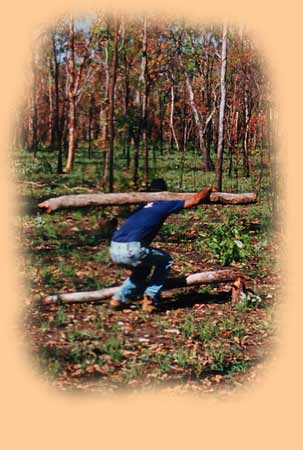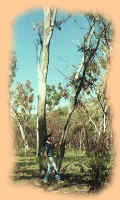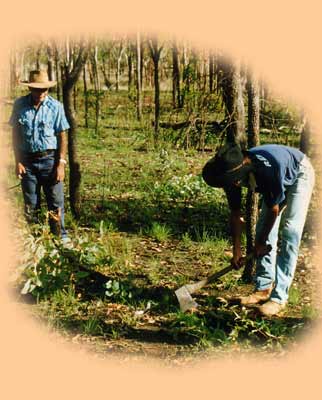 Didjeridoos
- instruments from the earth Didjeridoos
- instruments from the earth
Genuine didjeridoos are naturally hollowed out by termites.
Termites are very light-sensitive and can only survive in a dark, slightly humid environment. In the harsh Australian outback
they create these conditions for themselves.
Their colony is sealed to the outside world, even their 'roads' are fully enclosed, going for over fifty metres from the nest
to find food. They can also dig just as deep into the ground to find water. One termites' nest can have over one million individuals. Their closest
relative is the cockroach. Termites are not related to other ants.
 Termites can't go through
the living bark of the tree, they have to find access to the centre of a tree or sapling. They either follow a woodborer hole or make a tunnel
all the way up the outside of a tree to find a broken branch exposing the hardwood. Termites can't go through
the living bark of the tree, they have to find access to the centre of a tree or sapling. They either follow a woodborer hole or make a tunnel
all the way up the outside of a tree to find a broken branch exposing the hardwood.
Once inside the hardwood of the still alive tree, the termites eat the tree inside out.
More information about termites: http://www.csiro.au/resources/TermitesInNthAustEcosystems.html
http://www.ento.csiro.au/education/insects/isoptera.html
Recognising natural didjeridoos
In the northern parts of Australia are millions of potential didjeridoos spread over thousands of square kilometres, hidden in
living trees as well as in dead trees and branches.
How to find them?
Some cutters; especially non-indigenous cutters, just take a chainsaw and cut hundreds and thousands of trees to find a few hollow
ones, leaving carnage behind them.
 Aboriginal people feel
sad and resentful about that as the land and trees are sacred to them. Aboriginal people feel
sad and resentful about that as the land and trees are sacred to them.
 An Aboriginal
didjeridoo-maker walks for miles through the bush. Some say they can smell the termites, other can see from the shape of the tree, its leaves etc.
which ones are well hollowed. In any case, they cut only hollow trees and take only a few here and there without destroying the forest. An Aboriginal
didjeridoo-maker walks for miles through the bush. Some say they can smell the termites, other can see from the shape of the tree, its leaves etc.
which ones are well hollowed. In any case, they cut only hollow trees and take only a few here and there without destroying the forest.
Once they are carried to the four-wheel drive and taken home, a good didjeridoo maker allows the cut 'sticks' to season for a
few months.
A didj is born...
 Now the bark
is removed and the interior cleaned of the dirt the termites usually deposit in there. Then the outside is sanded and any holes are filled and
sealed. Now the didge needs only a beeswax mouthpiece and is ready to play. Now the bark
is removed and the interior cleaned of the dirt the termites usually deposit in there. Then the outside is sanded and any holes are filled and
sealed. Now the didge needs only a beeswax mouthpiece and is ready to play.
If it cracks after a while, that's OK, you can always go and get another one!
Well, the Aborigines can!
With over fifteen years of export experience, we're well aware that you can't do that. That's why we subject all of our didjeridoos
to over twenty-five further processes.
Check out about our didjeridoos to discover some of the additional things we do with
our didjeridoos to turn them into fine, long-lasting musical instruments. |

 Didjeridoos
- instruments from the earth
Didjeridoos
- instruments from the earth Termites can't go through
the living bark of the tree, they have to find access to the centre of a tree or sapling. They either follow a woodborer hole or make a tunnel
all the way up the outside of a tree to find a broken branch exposing the hardwood.
Termites can't go through
the living bark of the tree, they have to find access to the centre of a tree or sapling. They either follow a woodborer hole or make a tunnel
all the way up the outside of a tree to find a broken branch exposing the hardwood.  Aboriginal people feel
sad and resentful about that as the land and trees are sacred to them.
Aboriginal people feel
sad and resentful about that as the land and trees are sacred to them.  An Aboriginal
didjeridoo-maker walks for miles through the bush. Some say they can smell the termites, other can see from the shape of the tree, its leaves etc.
which ones are well hollowed. In any case, they cut only hollow trees and take only a few here and there without destroying the forest.
An Aboriginal
didjeridoo-maker walks for miles through the bush. Some say they can smell the termites, other can see from the shape of the tree, its leaves etc.
which ones are well hollowed. In any case, they cut only hollow trees and take only a few here and there without destroying the forest.  Now the bark
is removed and the interior cleaned of the dirt the termites usually deposit in there. Then the outside is sanded and any holes are filled and
sealed. Now the didge needs only a beeswax mouthpiece and is ready to play.
Now the bark
is removed and the interior cleaned of the dirt the termites usually deposit in there. Then the outside is sanded and any holes are filled and
sealed. Now the didge needs only a beeswax mouthpiece and is ready to play.